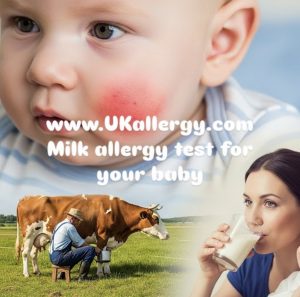Breastfeeding and Cow’s Milk Allergy in Babies: What Parents Need to Know<
Posted: 28th May 2025 | Posted by AdminMR
Breastfeeding and Cow’s Milk Allergy in Babies: What Parents Need to Know

Milk Allergy Test
What Is Cow’s Milk Allergy?
Cow’s milk allergy (CMA) is an immune-mediated reaction to one or more proteins in cow’s milk, such as casein or whey. There are two main types:
- IgE-mediated CMA – immediate allergic reactions, often within minutes to 2 hours of ingestion.
- Non-IgE-mediated CMA – delayed reactions, which can appear several hours or even days later and are typically gastrointestinal or skin-related.
A confirmed diagnosis via a reliable milk allergy test is key to managing the condition effectively.
The Role of Breastfeeding in Babies with Milk Allergy
Breastfeeding offers unmatched health benefits, including immune protection, gut development, and reduced risk of infection. For babies with CMA, breast milk remains the gold standard — but with one important consideration:
If a baby reacts to cow’s milk proteins while being breastfed, it means these proteins are passing through the mother’s diet into her milk.
This doesn’t mean you should stop breastfeeding. In fact, prolonging breastfeeding is strongly recommended. Instead, mothers are advised to eliminate cow’s milk and dairy products from their own diet under the guidance of a healthcare professional or dietitian.
Excluding Cow’s Milk from the Maternal Diet
When CMA is diagnosed in a breastfed baby, the first step is often maternal dietary adjustment:
- Remove all cow’s milk and dairy-containing products from your diet (e.g., milk, cheese, yoghurt, butter).
- Check food labels carefully for hidden sources of milk proteins such as whey, casein, lactose (in some cases), and milk solids.
- Ensure you’re still getting enough calcium and other essential nutrients — often through supplements or dairy-free alternatives.
Dietary changes should always be supervised to avoid nutritional deficiencies, especially in breastfeeding mothers.
Why Prolonged Breastfeeding Matters in Cow’s Milk Allergy
Breastfeeding for at least 6 months — and ideally up to 12 months or beyond — is linked with better outcomes for babies with food allergies:
- Supports immune system regulation, helping reduce future allergy risk.
- Protects the gut lining, which can be compromised in allergic conditions.
- Lowers the risk of infections that may otherwise trigger or worsen allergic responses.
In cases of non-IgE-mediated CMA, where symptoms may be subtle or delayed, breast milk provides gentle nutrition without triggering inflammation or gut upset (assuming maternal diet is dairy-free).
Combining Breastfeeding with Allergy Testing
If you suspect your baby has a milk allergy, the first step is accurate diagnosis. Our cow’s milk allergy test offers a reliable, easy-to-use, at-home option to identify milk-specific IgE antibodies. Once the allergy is confirmed, your care plan can include:
- Maternal dietary adjustments
- Referral to a paediatric dietitian
- Ongoing breastfeeding support
When to Seek Medical Advice
Always consult your GP, health visitor, or allergy specialist if your baby shows signs of cow’s milk allergy, such as:
- Eczema or hives (skin rashes)
- Vomiting or diarrhoea
- Blood or mucus in stools
- Colic or excessive crying
- Breathing difficulties or wheezing
- Poor weight gain
Early identification and proper management can significantly improve quality of life for both baby and parent.
Important Thoughts
Breastfeeding remains the best choice for babies with cow’s milk allergy, provided that cow’s milk is removed from the mother’s diet. It delivers essential nutrients and immune protection, while helping manage allergy symptoms in a natural, nurturing way.
If you’re concerned about a possible milk allergy in your baby, consider taking our cow’s milk allergy test and consult with a healthcare professional for tailored advice.
References
- Host A. Frequency of cow’s milk allergy in childhood. Ann Allergy Asthma Immunol. 2002;89(6 Suppl 1):33-37. doi:10.1016/S1081-1206(10)62105-3
- Vandenplas Y, Koletzko S, Isolauri E, et al. Guidelines for the diagnosis and management of cow’s milk protein allergy in infants. Arch Dis Child. 2007;92(10):902-908. doi:10.1136/adc.2006.110999
- Fiocchi A, Brozek J, Schünemann H, et al. World Allergy Organization (WAO) Diagnosis and Rationale for Action against Cow’s Milk Allergy (DRACMA) guidelines. World Allergy Organ J. 2010;3(4):57-161. doi:10.1097/WOX.0b013e3181defeb9
- Muraro A, Werfel T, Hoffmann-Sommergruber K, et al. EAACI food allergy and anaphylaxis guidelines: diagnosis and management of food allergy. Allergy. 2014;69(8):1008-1025. doi:10.1111/all.12429
- Allen KJ, Campbell DE, Assa’ad AH, et al. The role of breastfeeding in the prevention and management of cow’s milk allergy. Curr Opin Allergy Clin Immunol. 2020;20(3):234-240. doi:10.1097/ACI.0000000000000634
- Fleischer DM, Sicherer S, Greenhawt M, et al. Consensus communication on early peanut introduction and the prevention of peanut allergy in high-risk infants. Pediatrics. 2015;136(3):600-604. doi:10.1542/peds.2014-4022
- Lozinsky AC, Meyer R, Anagnostou K, et al. Cow’s milk protein allergy from diagnosis to management: a very different journey for general practitioners and parents. Children (Basel). 2015;2(3):317-329. doi:10.3390/children2030317
- Greer FR, Sicherer SH, Burks AW; American Academy of Pediatrics Committee on Nutrition; American Academy of Pediatrics Section on Allergy and Immunology. Effects of early nutritional interventions on the development of atopic disease in infants and children: the role of maternal dietary restriction, breastfeeding, timing of introduction of complementary foods, and hydrolyzed formulas. Pediatrics. 2008;121(1):183-191. doi:10.1542/peds.2007-3022
